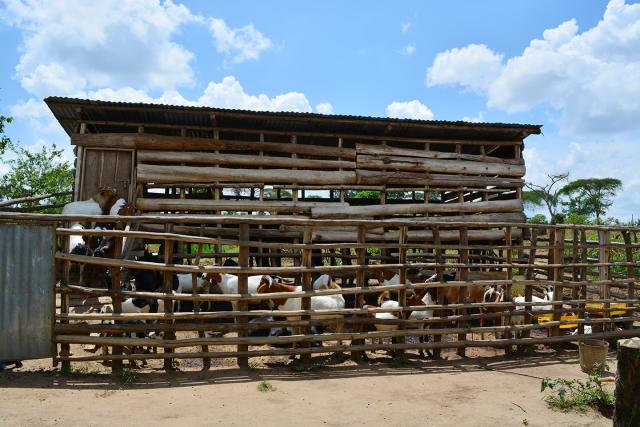

Goats naturally prefer open spaces where they can browse freely. This, however, is not practical for many farmers due to scarcity of land. A good shelter should be spacious enough to allow them comfortable movement.
It is recommended for an adult animal that at least 20sq.ft per goat is appropriate and for goats that are less than 30kg, 9sq.ft per goat is enough. It is important to note that the actual size required for each goat is dependent on the size of the animal as well as the physiological status. Causes stress and can also result in injuries especially of the weak ones. The shelter should also allow the farmer or caretaker ease of access when cleaning, inspecting or feeding the animals.
It is recommended that the structure be raised 2 to 3ft off the ground. This is important to keep the shelter dry during the wet seasons.
Stone-built pillars provide good permanent support for the structure.
The floor should be slatted (made of narrow pieces of wood) with spaces in between (at a gap of an index finger apart).
The gaps allow for the goat droppings and urine to fall on the ground where they can be collected and used as manure. The gaps need to be small to avoid the hooves of the goats getting trapped.
Ventilation
Since goats kept in such a structure will have restricted movement, the housing needs to be well-ventilated. This can be achieved by using wire mesh on the windows. This has a dual advantage in that it lets in fresh air as well as enough light.
It is advisable to have wooden shutters that can be closed at night or when it is raining. Have the windows, entrance and other ventilation should face away from the direction of the wind. Strong drafts are not good especially for young goats.
When designing the shelter, consider having the feeding and watering troughs outside of the sleeping area.
It is then easier to clean the troughs and avoid the contamination of water with goat droppings and urine.
Materials
To cut costs, consider using locally available materials that include wood planks for the sides and the floor and corrugated iron sheets for the roof.
The wood can be planed especially on the inside to remove grooves that can easily become hiding places for pests like ticks, lice and fleas or hurt the animal.
The farmer should regularly spray the shed, at least twice a week to get rid of the pests and parasites. Though some people may opt to construct the shelter themselves, the services of a professional carpenter are preferable.
Finally, partition the house so that the does, bucks and kids are kept in separate quarters. Isolating the goats ensures you control their mating and also that you feed them according to their needs.
 Contact Jaguza Support
Contact Jaguza Support